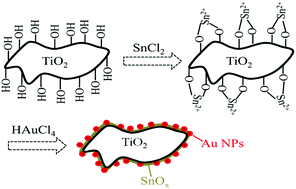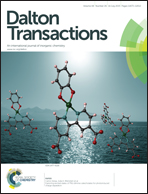In situ synthesis of TiO2/SnOx–Au ternary heterostructures effectively promoting visible-light photocatalysis
Abstract
TiO2/SnOx–Au ternary heterostructures were successfully fabricated via a simple in situ reduction of AuCl4− on TiO2 surfaces pre-modified with Sn2+. The samples were characterized by XRD, TEM, XPS, N2 physical absorption and UV-vis diffuse reflectance spectra. Photocatalytic activity toward degradation of methylene blue (MB) aqueous solution under visible light irradiation was investigated. The results suggested that the highly dispersive and ultrafine Au nanoparticles (NPs) covered with SnOx were deposited onto the surface of TiO2. The heterostructures significantly enhanced the photocatalytic activity compared with the traditional TiO2/Au sample prepared by the impregnation method and also enhanced the activity more than the binary TiO2/SnOx sample. Moreover, the size of the Au NPs could be well controlled by simply tuning the dosage of HAuCl4, and the optimized catalytic activity of the ternary heterostructures was obtained when the dosage of Au was 1% and the Au particle size was ∼2.65 nm. The enhancement of photocatalytic performance could be attributed to the surface plasmon resonance effect of the Au NPs and the electron-sink function of the SnOx, which improve the optical absorption properties as well as photoinduced charge carrier separation, synergistically facilitating the photocatalysis.


 Please wait while we load your content...
Please wait while we load your content...